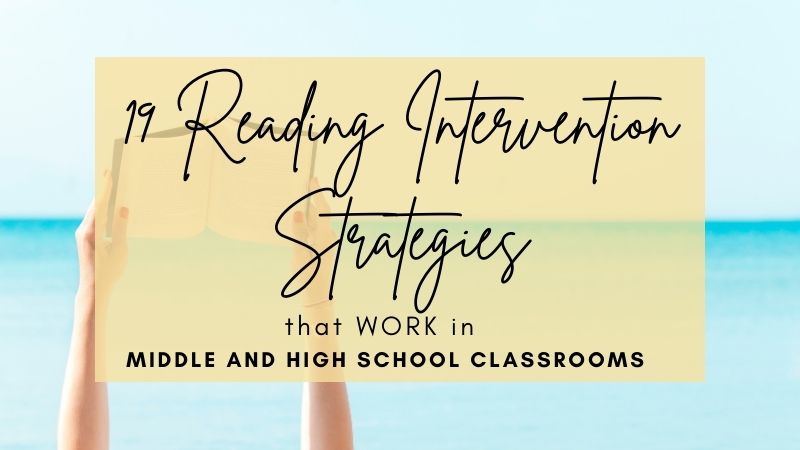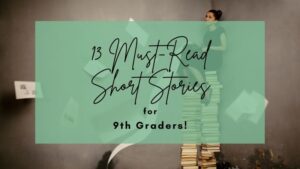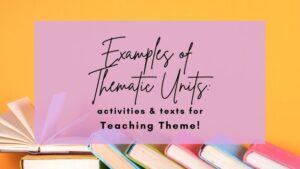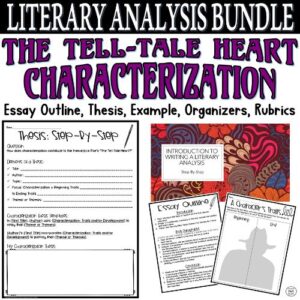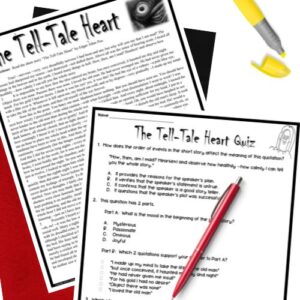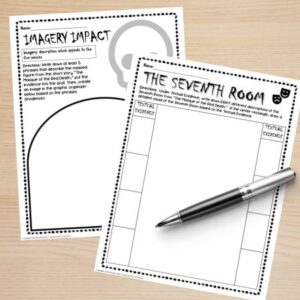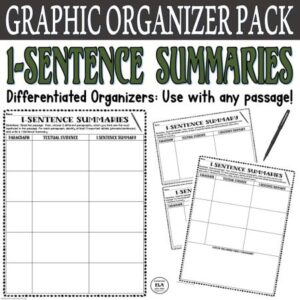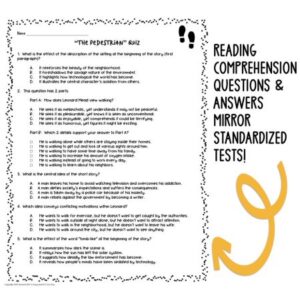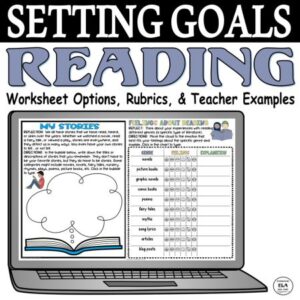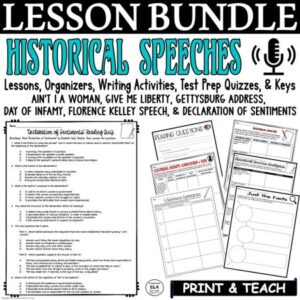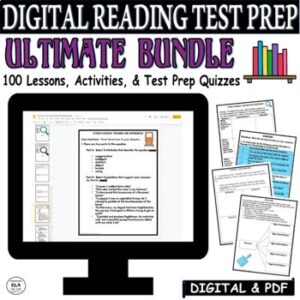Reading is such a tough issue to tackle as a middle/high school English, Language Arts, and/or Reading Teacher. So often, schools are inundated with reading intervention programs that promise success but cost a lot of money, are superscripted, or rely on 1:1 technology resources.
There are a bunch of subscriptions out there that have good outcomes for students, especially those that modulate the reading levels based on where the students are. Unfortunately, they are quite expensive.
I have, additionally, NEVER had a class with more than 4 or 5 computers; I know, sad. When I did get a computer cart, it was for testing every quarter or state standardized tests at the end of the year. I don’t personally believe students need access to technology every day, but when your reading program requires it, the lack of resources is pretty difficult to stomach.
To work within this difficult situation, I integrate reading intervention into what I already am doing as a teacher!
Below you can read about reading intervention techniques you can use with ANY class, no matter the reading level!
Keep reading for 19 Reading Intervention Strategies that WORK in Middle and High School Classrooms!
Need help with teaching what reading strategies will work while using Test Prep? Check out this FREE Pack of 3 Test Prep Activities to help students achieve success on standardized tests!
19 Reading Intervention Strategies that WORK in Middle and High School Classrooms

1. Teach students with mixed levels of reading abilities.
Many students are classified by what classes they are scheduled into. I wish I could say that students get to choose what classes they take, but most don’t. They are cataloged by scores, programs, or previous classes.
Because of this pretty typical situation, counselors corral higher-level reading students into AP, Honors, or Dual Enrollment classes, and students with average or below-average scores are placed into “regular” or “standard” classes.
I have major issues with this process:
- There are many students who can read well but have no desire or drive to take an Honors class. I would MUCH rather have a hardworking average or below-average reader in an Honors class than a higher-level reader who won’t do the reading or the work.
- A score on a single day of testing in the Spring is NOT always indicative of student ability or drive. If students want to take a specific class, I am pretty much all for it.
- Often, there is little to no difference between an Honors or AP class, except for the pacing. That is NOT what makes a class challenging.
- What used to be a standard English class is NOT the same as it would have been 20-30+ years ago. We have significantly underestimated what students are able to read, comprehend, and analyze!
- If you put all struggling readers into a single class, there will most likely be tons of discipline issues, unending expectations in terms of reading growth, and slow progress.
The BEST scores in my 17 years of teaching were with classes of about 50% at or above level readers and 50% below average readers. Go figure!
By using this class sorting for reading intervention, there were a fair amount of students who could read well, so they could always challenge each other; however, they were also willing to work with other students who were struggling readers. In fact, I had a student in AP Language, who could not pass the state reading test. I paired him with another really high-level reader, and by the end of the year, he passed the state test with not just a passing score but an ABOVE-AVERAGE (level 4) score!
2. Use MOSTLY higher-level reading texts in classroom instruction.
Instead of challenging reading intervention students with higher-level reading passages, too often, we give the whole class texts below grade level. The justification is that a text is more suited thematically for middle and high school students even though the actual reading level in terms of language, overall vocabulary, and syntax is MUCH lower.
For example, Of Mice and Men by John Steinbeck is usually taught in 8th or 9th-grade English classes; however, the actual reading level is more appropriate in terms of language for 5th-7th graders.
Now, I am not saying that 5th-7th grade students should be reading this book because of the sensitive nature of some of the book’s content and vocabulary.
But why not accomplish 2 goals for reading intervention?
- Teach books/texts at or above standard in terms of reading level.
- Choose books/texts with appropriately mature content.
Try engaging activities and lessons that don’t rely on ONLY the text and get students talking about how the text can relate to them; even higher-level texts within a reading intervention framework have relevant ideas for today’s students!
More Complex Short Stories:
- “The Most Dangerous Game”
- “An Occurrence at Owl Creek Bridge”
- “The Masque of the Red Death“
- “The Cask of Amontillado”
- “The Cactus”
- “The Tell-Tale Heart”
More Complex Poems:
- Poe’s “The Bells”
- Bradstreet’s “To My Dear and Loving Husband”
- Donne’s “Death Be Not Proud”
- Shelley’s “Ozymandias”
- Wordsworth’s “I Wandered Lonely as a Cloud”
- Dickinson’s “Because I could not stop for Death”
- Poe’s “Annabel Lee”
- Blake’s “A Poison Tree”
- Tennyson’s “The Charge of the Light Brigade”
More Complex Nonfiction Texts:
- Patrick Henry’s “Give Me Liberty” Speech
- FDR’s “Infamy” Speech
- Abraham Lincoln’s “Gettysburg Address”
- Elizabeth Cady Stanton’s “Declaration of Sentiments”
- Sojourner Truth’s “Ain’t I a Woman?
- Florence Kelley Child Labor Speech
- “A Modest Proposal”
- “Sinners in the Hands of an Angry God”
Click below to read about 13 Must-Read Short Stories for 9th Graders!
3. Incorporate a wide variety of genres.
Only including what students might be interested in for reading intervention is NOT really helpful. On the surface, you might think that choosing texts based on student interest is necessary. Maybe it is in the short run because students will seem engaged or might enjoy reading with you.
Like life, however, we cannot choose genres based on our feelings. How will students be able to read a voter ballot, tax documents, student loan information, college literature, etc. if they only read what they WANT to read?
I wish I only had to read what I wanted to read to be successful in college or in my career.
So to prepare my students for the inevitable, I try to include a wide variety of genres like the following in my reading intervention curriculum:
- News articles
- Satire
- Science fiction
- Fantasy
- Historical fiction
- Nonfiction
- Comedy
- Tragedy
- Horror
- How-To Guides
- Comic Strips
- Memes
- Videos
4. Include varied literary structures.
When we consider texts to use as a part of reading intervention, make sure to keep varied structures in mind.
For example, if students are only reading 1-page informational articles, their minds will get used to that structure. We want them to be successful with nonfiction reading passages, but there are plenty of other types of literature we want them to feel comfortable with.
Not every article has the same format. Change it up. Include a recipe, vary the subtitles, let students see a process, read a historical narrative, and examine an ad as a part of their nonfiction exposure within reading intervention.
When it comes to reading short stories, we want them to read 2-paragraph stories and 10-page stories. Not every story is built the same.
Additionally, we need to include various types of poems as there are sonnets, free verse stanzas, rhyming sequences, and limericks that all are valid forms of literature.
In essence, we want students to explore beyond the typical articles, novels, and short stories, because the world is full of so much more!
5. Utilize thematic units.
I absolutely love teaching through thematic units, especially when it comes to helping students with reading intervention progress. Every text is connected in some way, so students have a unifying thread to follow as they analyze literature.
If you want to include a unit on DEATH & DYING, you could include the following texts:
- “Ozymandias” (poem)
- “The Masque of the Red Death” (short story)
- “The Monkey’s Paw” (short story)
- “Because I Could Not Stop For Death” (poem)
- “The Shroud” (poem)
- “The Scarlet Plague” (fiction passage)
Or you could change it up with a unit of LOVE IN LITERATURE!
- “Annabel Lee” (poem)
- “To My Dear and Loving Husband” (poem)
- “The Gift of the Magi” (short story)
- Romeo and Juliet (play)
Many of the same ideas and concepts are reinforced by using this reading intervention strategy when students can see a thematic thread throughout a more sustained period of time!
6. Introduce vocabulary based on what you are reading.
I am not a huge fan of teaching vocabulary in isolation as it doesn’t really help with reading intervention growth. Most language skills are cultivated within real-world settings and through reading. That is how most of us learned the words we know.
Because of this reality, I try to teach vocabulary based on the texts I am teaching. If you are reading “The Tell-Tale Heart,” you may want to start off by introducing the following vocabulary:
- dreadfully
- conceived
- resembled
- sufficient
- stealthily
- distinctness
- precisely
- fury
- reposed
- hideous
You can review the words ahead of time, have students write a note in their texts, use the words in another sentence, visualize the word, write down a synonym or antonym, etc.
As you read the text, they will be more likely to remember the words!
And as a culminating activity, you could have students write a short summary in which they have to use 3 words effectively. Over time, their lexicon will grow through these reading intervention techniques!
Want to teach “The Tell-Tale Heart,” but you need a bit of help? Click below!
7. Read with your students.
Reading with your students does not mean you have to spend hours each day reading to every class. What it does mean is that you read at least the first sections of a text or the most important excerpts of the passage. Honestly, this strategy is probably one of my favorites when it comes to effective reading intervention.
For example, if you are reading “The Tell-Tale Heart” by Edgar Allan Poe, break up the story into chunks. Maybe read the first several chunks with your students aloud and then read allow a fluent reader to read another chunk or use an audio version for the next parts.
Try having students read the paragraph about the speaker hearing the heartbeat or the last paragraphs that detail the speaker’s confession! Trust me; students will want to know the ending!
8. Reread complex texts.
Don’t tackle any sort of poetry or classic essay without this mentality. I am not saying you need to reread the WHOLE text; however, rereading is necessary.
So many struggling readers believe they are bad readers if they have to reread something. This situation could not be further from the truth.
Good readers REREAD! Now, louder for the people in the back! GOOD READERS REREAD!!
9. Provide background knowledge before reading.
I don’t know that you need to do this for every text, but it can be helpful for certain reading passages when you provide some context.
Let’s say you are reading “The Masque of the Red Death,” you may want to have students watch a short video on the black plague. Most people at the time did not truly understand how the disease was transferred, and many myths persisted over time.
The same thing happens today. As time goes on and knowledge is increased, different methods are utilized within the field of medicine.
Providing this background knowledge ahead of time can allow for greater comprehension during the reading of the actual text, which is the reading intervention goal!
10. Let students productively help each other.
I am not talking about cheating here or creating duplicate work as a part of the reading process. When students in pairs or very small groups work together, however, they can offer insight, a different perspective, or a reading tool a student may not have considered before.
Having a higher-level reader demonstrate how to find a good piece of evidence or allowing students to read each other’s responses aloud can be very helpful. Plus, it empowers students to become leaders and self-learners instead of disengaging from the goal task.
11. Offer time to let students talk about what they are reading.
Overall, I am a huge proponent of discussions, and often students in reading intervention classes don’t get to participate in regular discussions. Good Socratic Seminars are my highlights as a teacher. Whole group discussions can be a bit cumbersome as usually several students dominate.
Instead, I like to differentiate classroom discussions and develop them into more rigorous and purposeful Socratic Seminars:
- Whole Group Seminars: Personally, I think this type is the least effective. If you have 30+ students and the class is 60-90 minutes long, there is not a lot of time for everyone to participate. This is most especially true when 5 or 6 students dominate the discussion.
- Half-Class Seminars: I really like this way of conducting a seminar. You can divide your students into pairs. If you have 30 students, 15 will participate for 10 minutes at a time and then switch out. This process definitely lets students who are quieter get into the action.
- Small Group —> Lead to Whole-Group Seminars: So this type is my favorite, and my students have the most fun in this type of seminar. It does, however, require lots of discipline when you start out. 1) Divide a class of 30 students into 5 or 6 groups. 2) Put the groups on the outside of the main discussion circle. 3) One student from each group participates at a time. 4) After 5 minutes, let 1 student from each group sub out, or after each student talks/participates, he/she can silently trade out with another person in the group. ***If a group member sits there without talking for a while, feel free to tell him/her that another turn will come around.
- Pair Seminars: After pairs of students conference with each other, you could spotlight each pair for a minute to five minutes of discussion. This type of seminar might be helpful as an exemplar discussion to give students an idea of how to participate.
Ultimately, when students discuss, they engage and grow, and really, this outcome is what we hope to achieve in the reading intervention process!
12. Employ writing activities every day.
When students write something down, they are more likely to remember what they read. Keep in mind; you don’t have to assign full essays every day. I would get overwhelmed by an essay a day, and I love writing.
Instead, vary what you require from your students as a part of your reading intervention regimen.
- Annotate as you read; be sure to model what this looks like.
- Write a 1-Sentence Summary for a paragraph, chunk, or page of a passage.
- Analyze a quote and write about what it means in 2-3 sentences.
- Give students time to respond in a 1-paragraph format.
- Practice writing sentences with vocabulary from the text.
- Create a comic strip with dialogue based on the literature.
There are so many ways to integrate reading and writing with a reading intervention focus!
13. Practice test-taking skills.
One element we cannot escape is standardized testing. And really, tests exist to measure where students are. Sometimes, there are issues with these tests; however, we need to prepare our students to the best of our ability!
There is nothing wrong with including a quick test prep quiz as a part of reading intervention for a short story, play, or poem. You can teach what you like and help your students answer questions effectively!
Here are the example test prep questions for the short story “The Pedestrian” by Ray Bradbury:
This question has 2 parts.
Part A: Reread the last 4 sentences of the story. What does the word illumination most likely mean? Choose 2.
□Color
□Darkness
□Radiance
□Confusion
□Brightness
□Excitement
Part B: What does the word illumination reveal about Leonard?
A. It emphasizes his insight about living that others do not possess.
B. It highlights that he likes lights on in his home all day.
C. It illustrates his obsession with life and death.
D. It recalls a time when he was younger.
Notice, we are not simply asking for recall or “right there” responses. We are asking students to use context clues and examine the meaning of the words used in the story!
Click HERE or below for a QUICK way to measure your students’ comprehension of “The Pedestrian!”
TEST-TAKING TIPS FOR READING INTERVENTION:
- Expose students to 2-part questions. They can be a little tricky.
- Read the answer options from bottom to top. This process helps ensure they are reading all of the answer choices.
- Use elimination. Even getting down to 2 options is super helpful.
- Go back and reread the text. Students don’t have to reread the entire passage, but they should be able to locate the excerpt that helps to answer the question.
- As you read, take short notes (annotations).
- Read until the end; so often, students don’t read the whole text.
14. Pull-out students who need individualized attention.
Even if you focus on 2-3 students every week from each class for 5 minutes a day in a small group, I would encourage you to do so.
After you assign the work to the whole class, call up a small group of students to help them individually on the same activity, a revised version of the activity, or something else entirely.
Plus, this process helps you develop a relationship with these struggling students who need the most help and encouragement through the reading process.
15. Engage students with shorter, higher-level activities.
I truly believe that every text can be made interesting in a reading intervention classroom, even older, more classic pieces of literature that many people avoid.
You would think that “A Modest Proposal” might not be interesting to a 10th-grade struggling reader, but satire is everywhere. When you start with “Sending Grandma to the Ovens,” reading “A Modest Proposal” can be made more palatable for even the lowest-level readers in the room.
Incorporating political cartoons or satirical videos will help set the stage for reading higher-level passages. When students start by participating in more engaging activities with complex texts, they will be more likely to comprehend and enjoy what they are reading!
16. Help students set reading goals.
At the start of the year, I really enjoy the act of writing down goals as a part of the reading intervention classroom. If you don’t have a goal, how do you plan on meeting a specific challenge?
Check out this Reading Goals Pack to assist your students in setting specific goals throughout the year!
17. Scaffold your lessons throughout the year.
You definitely don’t want to start the year by having students write an entire essay or take a 50-question reading test in a reading intervention environment. I know this situation might be inescapable as some schools begin the year this way. Instead, I like to see the results of standardized tests from the previous year and build from there.
Start small and build up!
You could begin with a 5 or 10-question reading quiz and a 2-paragraph essay (introduction and 1 body paragraph).
These above activities will give you exactly what you need to meet students where they are.
As you review their work, ask these reading intervention questions:
- Do they know how to write a thesis?
- Do they know how to use evidence?
- Do they understand the meaning of the message?
- Do they respond correctly to certain reading questions versus others?
- Do they even take the assessments seriously?
Then, we plan for reading intervention based on the texts we are required to read or really know would help our students grow the most.
You might not have your students take a 50-question test until halfway through the year. You might not have students write a 2+ page essay until February.
And that is okay!
If you start with writing 1 sentence thesis statements for the first month, move on to writing an introduction in the second month, add a body paragraph in month three, incorporate another body paragraph for the fourth month, and don’t get to the conclusion until a month or two before the state test, I think your students will be fine. Remember, reading intervention strategies are not a one-and-done process. It takes lots of practice, practice, practice!
The goal is to practice the above elements ALL of the time when it comes to writing and reading intervention.
18. Identify students’ individual struggles (phonics, fluency, vocabulary, pronunciation).
I know this element can be difficult. Most schools have state or formative assessments you can examine from years past to see areas of weakness and strength. I would spend a bit of time examining these past results. One of the past schools I taught at allowed me to view several years of results. Looking at trends over time is super helpful, especially when you notice certain consistencies and inconsistencies.
For instance, if a student failed one year but passed every other year, perhaps the results had nothing to do with academics.
If another student has consistently earned the lowest possible score every year, more often than not, extreme reading intervention and encouragement are needed. Can you imagine the feeling of failing the state test over and over again?
We need to also chat individually with our students. A simple talk reveals a ton, even if students don’t say much.
Take a couple of minutes and ask them these questions before beginning any reading intervention activities:
- Describe the process of taking the state test.
- How do you feel about reading? Or writing?
- What do you think you struggle with the most?
- What do you think you do well academically?
- How long does it take you to read and answer questions?
- At what point do you get frustrated with reading a passage?
- Why do we need to be able to read well in today’s age?
I love talking with my students, but if you want them to respond in writing instead, that is okay, too!
19. Read informational texts and/or historical texts and connect them to real-life scenarios.
You might have the ability to move around certain texts or units, and I really hope you do. Starting out the year with reading Romeo and Juliet or writing a major research paper is pretty much not in the cards within my classroom. I start with easier or simpler activities and build from there.
For instance, my 9th grade classes might wait until January to start argumentation, because I will cover narrative writing in the first quarter and exposition in the second quarter. Or I might wait until February or March to begin Romeo and Juliet, because I want to include narrative-based reading passages in the first part of the school year to complement the writing focus.
Want EASY-TO-TEACH speech lessons as a part of your reading intervention curriculum? Click below!
Reading Intervention DON’TS
- Don’t force students to read aloud if they don’t want to. Now, if you are trying to make sure that they are following along, have students read like 3 or 4 words aloud to show they are reading with you. Through this method, they can demonstrate their fidelity to the reading process but won’t feel the pressure to read aloud for a long period of time.
- Don’t require out-of-class reading beyond 5-10 minutes at a time. I used to require LOTS of reading, but the success rate was pretty minimal. I mean, students are in class 7-8 hours a day and then have 7-8 classes they are responsible for in terms of homework. That can be tough to handle for anyone, especially those who need reading intervention!
- Don’t lessen the requirements of the standards. Scaffold up for reading intervention effectiveness!
Look no further than this list as an easy start on your reading intervention journey!
Check out the READING TEST PREP BUNDLE below for reading test prep lessons and activities that include over 400+ test prep questions to help with reading intervention!
Need more ideas for reading intervention activities and reading test prep lessons? Check out my store Kristin Menke-Integrated ELA Test Prep!

